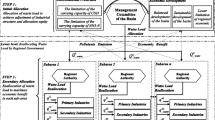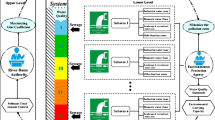Abstract
It is often difficult to apply existing waste load allocation (WLA) models to management institutions at all levels of the river basin because the existing WLA models do not consider the principles of fairness and efficiency at each management level of the basin. The implementation of environmental protection tax law has also greatly impacted WLA. This paper proposes the bi-level multiobjective allocation model under an environmental protection tax law to solve the WLA problem for different management levels. The upper allocation targets the minimal environmental Gini coefficient and the minimal unit pollutant emission cost. The impact of the environmental protection tax is also considered. The targets of the lower-level allocation are the maximal industrial output value and the minimal unevenness of reduction rates. The proposed model was applied to the case of the Wei River basin, and the results demonstrated that the bi-level multiobjective allocation model could solve the problem of WLA under an environmental protection tax law. Each level of the bi-level multiobjective allocation model considers the principles of fairness and efficiency to distribute the load in the basin, thereby offering a better reference for decision-makers at both levels.








Similar content being viewed by others
References
Ashtiani EF, Niksokhan MH, Ardestani M (2015) Multi-objective waste load allocation in river system by MOPSO algorithm. Int J Environ Res 9:69–76
Chen B, Gu C, Wang H, Tao J, Wu Y, Liu Q, Xu H (2012) Research on Gini coefficient application in the distribution of water pollution. J Food Agric Environ 10:833–838
Chinyama A, Ncube R, Ela W (2016) Critical pollution levels in Umguza River, Zimbabwe. Phys Chem Earth 93:76–83. https://doi.org/10.1016/j.pce.2016.03.008
Cho JH, Lee JH (2014) Multi-objective waste load allocation model for optimizing waste load abatement and inequality among waste dischargers. Water Air Soil Pollut 225:17
De Andrade LN, Mauri GR, Mendonca ASF (2013) General multiobjective model and simulated annealing algorithm for waste-load allocation. J Water Resour Plan Manage ASCE 139:339–344
Heon CJ (2013) Application of multi-objective genetic algorithm for waste load allocation in a river basin. J Environ Impact Assess 22:713–724
Hou SH, Song XL, Yao LM (2015) A bi-level waste load allocation model based on water function zoning for Sichuan-Neijiang. In: Xu J, Nickel S, Machado VC, Hajiyev A (eds) Proceedings of the ninth international conference on management science and engineering management, vol 362. Springer-Verlag, Berlin, pp 209–220
Li RZ, Shu K (2011) Model for wastewater load allocation based on multi-objective decision making. Acta Sci Circumst 31:2814–2821. https://doi.org/10.13671/j.hjkxxb.2011.12.031 (in Chinese)
Li YX, Qiu RZ, Yang ZF, Li CH, Yu JS (2010) Parameter determination to calculate water environmental capacity in Zhangweinan canal sub-basin in China. J Environ Sci 22:904–907. https://doi.org/10.1016/S1001-0742(09)60196-0
Liang SD, Jia HF, Yang C, Melching C, Yuan YP (2015) A pollutant load hierarchical allocation method integrated in an environmental capacity management system for Zhushan bay, Taihu lake. Sci Total Environ 533:223–237
Liu J, Diamond J (2005) China’s environment in a globalizing world. Nature 435:1179–1186
Liu DD, Guo SL, Shao QX, Jiang YZ, Chen XH (2014) Optimal allocation of water quantity and waste load in the northwest pearl river delta, China. Stoch Env Res Risk A 28:1525–1542
Meng C, Wang XL, Li Y (2017) An optimization model for waste load allocation under water carrying capacity improvement management, a case study of the Yitong River, Northeast China. Water 9:16
Mooselu MG, Nikoo MR, Sadegh M (2019) A fuzzy multi-stakeholder socio-optimal model for water and waste load allocation. Environ Monit Assess 191:16
Nikoo MR, Beiglou PHB, Mahjouri N (2016) Optimizing multiple-pollutant waste load allocation in rivers: an interval parameter game theoretic model. Water Resour Manag 30:201–4220
Pang YY (2010) Research on permissible pollution bearing capacity and wasteload allocation in Lakes Basin. Dissertation, Zhengzhou University. (in Chinese)
Rafiee M, Lyon SW, Zahraie B, Destouni G, Jaafarzadeh N (2017) Optimal wastewater loading under conflicting goals and technology limitations in a riverine system. Water Environ Res 89:211–220
Shu SH, Ma HA (2010) Comparison of two models for calculating water environment capacity of songhua river. In: Li K, Jia L, Sun X, Fei M, Irwin GW (eds) Life system modeling and intelligent computing, vol 6330. Springer-Verlag, Berlin, p 683. https://doi.org/10.1007/978-3-642-15615-1_80
Soltani M, Kerachian R (2018) Developing a methodology for real-time trading of water withdrawal and waste load discharge permits in rivers. J Environ Manag 212:311–322
Soltani M, Kerachian R, Nikoo MR, Noory H (2016) A conditional value at risk-based model for planning agricultural water and return flow allocation in river systems. Water Resour Manag 30:427–443
Sun T, Zhang H, Wang Y, Meng X, Wang C (2010) The application of environmental Gini coefficient (egc) in allocating wastewater discharge permit: the case study of watershed total mass control in Tianjin, China. Resour Conserv Recycl 54(9):601–608
Wang HD, Wang SH, Bao QS, Qi Z (1995) On regional differentiation of river water environment capacity and strategies to control water environment pollution in China. Chin Geogr Sci 5:116–124. https://doi.org/10.1007/bf02664322
Wang M, Luo B, Zhou W, Huang Y, Liu L (2011) The application of Gini coefficient in the total load allocation in Jinjiang river, China. IEEE 2:992–995. https://doi.org/10.1109/ISWREP.2011.5893179
Wang F, Li Y, Yang J, Sun Z (2016) Application of wasp model and Gini coefficient in total mass control of water pollutants: a case study in Xicheng canal, China. Desalin Water Treat 57:2903–2916
Wu WJ, Gao PQ, Xu QM (2019) How to allocate discharge permits more fairly in China?-a new perspective from watershed and regional allocation comparison on socio-natural equality. Sci Total Environ 684:390–401
Xu JP, Zhang MX, Zeng ZQ (2016) Hybrid nested particle swarm optimization for a waste load allocation problem in river system. J Water Resour Plan Manag ASCE 142:19
Xu JP, Hou SH, Yao LM, Li CZ (2017) Integrated waste load allocation for river water pollution control under uncertainty: a case study of Tuojiang river, China. Environ Sci Pollut Res 24:17741–17759
Yan HZ (2003) Tehnieal Anaylsis and Eeonomic comparison of the projects to treat the sewage in small towns. Dissertation, Wuhan University of Technology. (in Chinese)
Zewdie M, Bhallamudi SM (2012) Multi-objective management model for waste-load allocation in a tidal river using archive multi-objective simulated annealing algorithm. Civ Eng Environ Syst 29:222–230
Zhang R, Qian X, Li HM, Yuan XC, Ye R (2012a) Selection of optimal river water quality improvement programs using QUAL2K: a case study of Taihu Lake Basin, China. Sci Total Environ 431:278–285
Zhang Y, Wang XY, Zhang ZM, Shen BG (2012b) Multi-level waste load allocation system for xi’an-Xianyang section, weihe river. In: Yang Z, Chen B (eds) 18th biennial ISEM conference on ecological modelling for global change and coupled human and natural system, vol 13. Elsevier Science Bv, Amsterdam, pp 943–953
Zhang MX, Ni JN, Yao LM (2018) Pigovian tax-based equilibrium strategy for waste-load allocation in river system. J Hydrol 563:223–241
Zhao CC, Ma HR, Yang XY, Liu LT (2008) Analysis of water environmental organic pollution load and its capacity in Xianyang section of Weihe River. Environ Sci Technol 31:65–67. https://doi.org/10.19672/j.cnki.1003-6504.2008.08.016 (in Chinese)
Zhou XD, Guo JL, Cheng W, Song C, Cao G (1999) The comparison of the environmental capacity calculation methods. J Xi’an Univ Technol 15:1–6. https://doi.org/10.19322/j.cnki.issn.1006-4710.1999.03.001 (in Chinese)
Funding
This work was supported by the National Key R&D Program of China under Grant No. 2016YFC0401409, the National Natural Science Foundation of China under Grant Nos. 51679186, 51679188, 51709222, and the Research Fund of the State Key Laboratory of Eco-hydraulics in Northwest Arid Region under Grant No. 2019KJCXTD-5.
Author information
Authors and Affiliations
Corresponding author
Ethics declarations
Conflict of interest
The authors declare that they have no conflict of interest.
Additional information
Responsible Editor: Marcus Schulz
Publisher’s note
Springer Nature remains neutral with regard to jurisdictional claims in published maps and institutional affiliations.
Rights and permissions
About this article
Cite this article
Zhang, X., Luo, J. & Xie, J. A bi-level multiobjective optimization model for waste load allocation in rivers. Environ Sci Pollut Res 27, 5122–5137 (2020). https://doi.org/10.1007/s11356-019-07189-1
Received:
Accepted:
Published:
Issue Date:
DOI: https://doi.org/10.1007/s11356-019-07189-1




